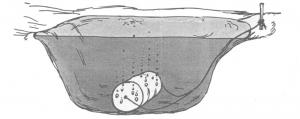1997 - Volume #21, Issue #5, Page #29
[ Sample Stories From This Issue | List of All Stories In This Issue | Print this story
| Read this issue]
Rotting Straw cleans Up Farm Ponds
 |
Researcher Greg Paranich of Lamont County ag service in Alberta says the rotting straw retards the growth of algae. That's because the microbes that break down the straw also consume phosphorus, which is needed by algae.
A 2,500 cubic yard pond requires three or four 45-gal. barrels of straw. The top of the barrels should not be cut off. Instead, cut the lid all the way around except for a 4 to 5-in. portion that serves as a hinge. Fasten a hasp to the barrel (in the same way that a padlock is installed) and use a snap to keep the lid closed. Perforate the entire barrel with 20 to 30 holes, each about 2 1/2 in. in diameter, to let water flow through freely.
Drill a 1/2-in. dia. hole into each end of the barrel and thread a 1/4-in. dia. nylon rope through the holes. Then tie the rope to form a loop outside the barrel. Drop a 30 to 40-lb. weight (rocks or scrap iron) into the barrel to add ballast.
Fill the barrel one-third full with chopped straw and saturate it with water to remove any air pockets. Then add more straw and keep saturating it until the barrel is full of water and straw. After closing the lid, place the barrel in the water and tie the end of the rope to a stake.
The rotting straw will compete with the algae for available phosphorus and will, in effect, starve much of the algae to death over a 3-month period.
A severely infested pond should first be treated with lime or bluestone to clean up the water. The addition of straw will then prevent regrowth of the algae. After three months use a front-end loader to pull the barrels out, dump out the straw, and then refill the barrels.

Click here to download page story appeared in.

Click here to read entire issue
To read the rest of this story, download this issue below or click here to register with your account number.




